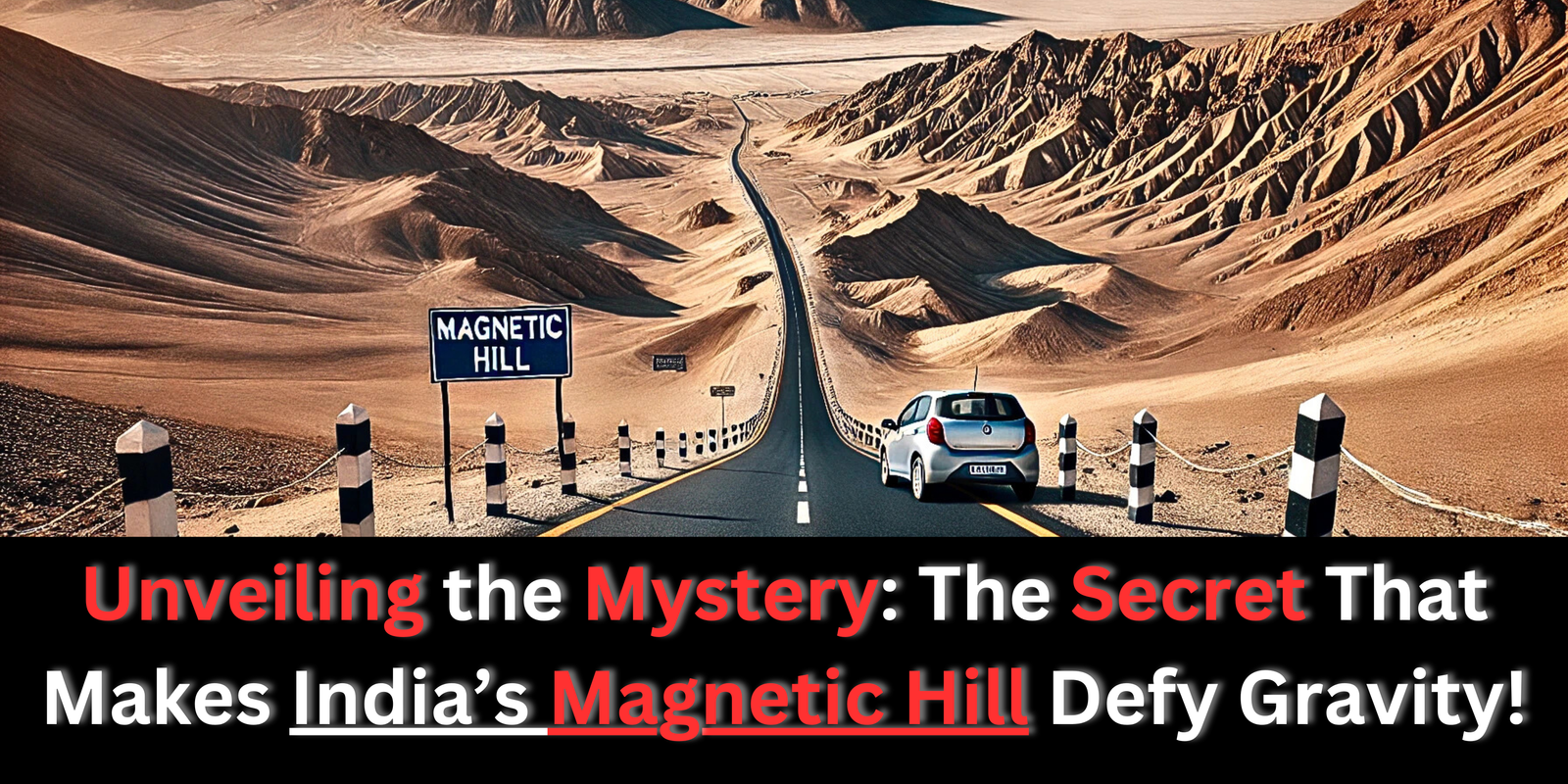India is a country of endless wonders, blending ancient traditions with enigmatic phenomena. Among its numerous marvels lies a phenomenon so extraordinary that it defies the laws of gravity: the Magnetic Hill of Ladakh. Imagine a car rolling uphill on its own, a force seemingly pulling you toward the heavens. Is it magic, science, or simply an illusion?
This iconic hill, nestled in the rugged terrains of northern India, has left visitors and scientists both amazed and puzzled. India has many hidden gems, but the Magnetic Hill stands apart as a true testament to the mystique of the land. In this comprehensive exploration, we’ll unravel the secrets behind this strange phenomenon, share detailed experiences, and explain why Magnetic Hill should be on every traveler’s bucket list.
Understanding India’s Magnetic Hill
The Magnetic Hill is located in Ladakh, a union territory in northern India known for its breathtaking landscapes, high-altitude deserts, and ancient monasteries. But what sets this hill apart is the incredible phenomenon it displays. Vehicles left in neutral on a specific spot appear to roll uphill, defying the basic principles of physics. For many, this is a perplexing mystery that fuels curiosity.
This natural marvel has drawn visitors from all over the world to witness what is often described as an experience that challenges reality. But before we dive deeper into the science and legends, let’s understand the geographical significance of this iconic spot.
The Geographic Marvel of Magnetic Hill
Ladakh, often referred to as the Land of High Passes, is home to some of India’s most captivating landscapes. The Magnetic Hill is situated on the Leh-Kargil-Baltic National Highway, at an altitude of about 14,000 feet above sea level. The area around the hill is a stunning blend of barren mountains, clear blue skies, and winding roads.
Travelers visiting the Magnetic Hill are greeted by a signboard placed by the Border Roads Organization. It marks the location of the phenomenon, directing visitors to the exact spot where vehicles start to move uphill without engine power. This particular stretch of road has become an iconic symbol of Ladakh, a must-visit destination for both adventure seekers and the curious.
The Science Behind Magnetic Hill: An Optical Illusion?
At first glance, the Magnetic Hill seems to defy gravity itself. But as intriguing as it sounds, scientists have determined that this phenomenon is not due to any magnetic forces but rather an optical illusion created by the layout of the land.
How Does the Illusion Work?
The surrounding topography plays a critical role in creating this effect. The hill’s background, coupled with the absence of a clear horizon, confuses the human brain. What appears to be an uphill slope is, in fact, a gentle downhill incline. Without a visible reference point, the slope looks reversed, and objects on it seem to defy gravity.
This type of natural phenomenon isn’t exclusive to India. Gravity hills exist in other parts of the world, but India’s Magnetic Hill is particularly famous due to its location in the majestic Himalayas.
Magnetic Forces or Just a Myth?
For years, locals and visitors believed that the Magnetic Hill had an extraordinary magnetic field strong enough to pull vehicles uphill. Some even speculated that the magnetic pull was so powerful that it interfered with aircraft flying over the region. However, scientific studies have debunked these claims, proving that the effect is purely visual.
While the magnetic field theory adds to the mystique of the location, it’s the optical illusion that continues to amaze everyone who visits.
Legends and Myths Surrounding India’s Magnetic Hill
Every mysterious place has its share of legends, and the Magnetic Hill is no exception. Local folklore paints a spiritual picture of this enigmatic spot. According to ancient Ladakhi beliefs, the Magnetic Hill was considered a gateway to heaven. It is said that those who were pure-hearted and deserving would be pulled toward the hill, while others would remain grounded.
This myth has added a spiritual dimension to the hill, making it more than just a scientific curiosity. For many visitors, the hill is not only a place of wonder but also one of contemplation and spiritual awakening.
Experiencing Magnetic Hill: A Traveler’s Guide
To fully appreciate the marvel of India’s Magnetic Hill, one must experience it firsthand. Whether you’re an adventure enthusiast or a curious traveler, here are some tips to make the most of your visit:
- Drive to the Spot: Park your vehicle in neutral at the designated spot marked by the Border Roads Organization and watch the magic unfold.
- Use Lightweight Objects: If you’re skeptical, place a water bottle or a ball on the ground to see them “roll uphill.”
- Record the Experience: Capture the moment on camera to relive and analyze the phenomenon later.
Best Time to Visit
The ideal time to visit Ladakh and the Magnetic Hill is between May and September when the weather is pleasant, and the roads are accessible. During winter, heavy snowfall can make the region challenging to navigate.
Ladakh: More Than Just Magnetic Hill
While the Magnetic Hill is a star attraction, Ladakh offers countless other wonders to explore:
- Pangong Lake: A mesmerizing high-altitude lake that changes colors throughout the day.
- Nubra Valley: Famous for its sand dunes, double-humped camels, and scenic vistas.
- Thiksey Monastery: A stunning Buddhist monastery offering panoramic views of the surrounding landscapes.
Conclusion: Why Magnetic Hill Is a Must-Visit in India
India is a treasure trove of natural and cultural marvels, and the Magnetic Hill is one of its most unique offerings. Visiting this spot is not just about witnessing a gravity-defying phenomenon; it’s about immersing yourself in the magic of Ladakh, where nature, science, and spirituality blend seamlessly.
India’s Magnetic Hill continues to fascinate people from around the world. Whether you visit for the science, the folklore, or the stunning Himalayan backdrop, this unique spot offers an experience like no other. It’s a testament to the wonders hidden in India’s diverse landscapes and a reminder of how perception can often defy reality.
Latest Updates







 Let’s imagine, explore, and uncover the mysteries together!
Let’s imagine, explore, and uncover the mysteries together!